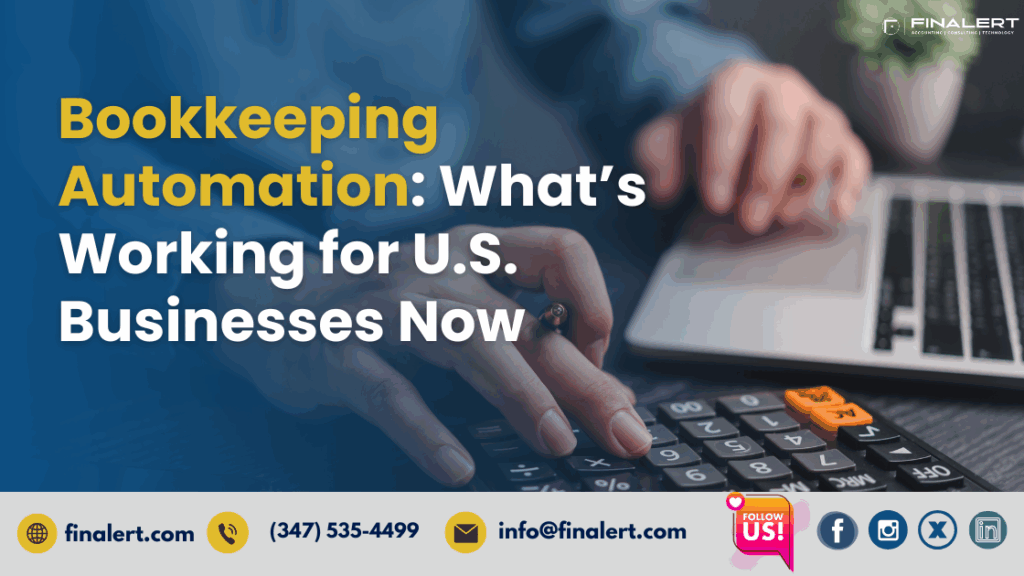
Bookkeeping, once a painstaking and manual process, has undergone a revolution in recent years. In the modern business landscape of 2025, automation isn’t just a competitive edge—it’s fast becoming a necessity. From startups to large enterprises, U.S. businesses are embracing automation tools to streamline bookkeeping, reduce errors, save costs, and increase accuracy.
This article explores what’s currently working in the world of bookkeeping automation, revealing the best practices, technologies, and trends shaping financial operations for U.S. businesses today.

Manual data entry has long been a time-consuming and error-prone component of bookkeeping. Today, artificial intelligence (AI) algorithms are transforming this process. By automatically capturing, reading, and categorizing financial data from receipts, invoices, and bank feeds, businesses are dramatically reducing their reliance on manual labor.
Modern platforms now use AI to learn spending patterns and categorize transactions accordingly, improving over time as they receive more data. This self-learning ability ensures higher accuracy and decreases the need for constant human intervention.
Bank reconciliation—matching company records with bank statements—used to take hours or even days. With bookkeeping automation tools, this task now happens in near real-time. Systems can auto-match transactions, flag inconsistencies, and highlight missing or duplicate entries for human review.
Additionally, smart automation can detect errors before they snowball into costly compliance issues. Whether it’s duplicate invoices, mismatched figures, or suspicious transactions, automation brings early warnings and improved data hygiene.
One of the most important developments in bookkeeping automation is the rise of cloud-based platforms. These systems allow teams to access financial records anytime, anywhere, and from any device—perfect for remote and hybrid work environments.
Cloud-based solutions also ensure regular backups, seamless updates, and instant synchronization across departments or locations. This enhances collaboration between business owners, finance teams, and external accountants.
Today’s automated bookkeeping platforms aren’t standalone systems. They integrate seamlessly with point-of-sale (POS) systems, payroll software, CRM platforms, e-commerce stores, and tax tools. This interoperability eliminates silos and creates a single source of financial truth.
For instance, a sale made through an online store can be automatically recorded in the ledger, inventory can be updated, and the tax amount can be calculated in real-time—all without human input.
This integration ensures that bookkeeping becomes an effortless extension of day-to-day operations rather than a separate, manual chore.
Bookkeeping automation isn’t limited to tracking expenses and recording income—it also streamlines the payment lifecycle. Automated systems can generate and send invoices, follow up with payment reminders, and even apply late fees if needed.
Recurring invoices can be scheduled, and payment confirmations can be automatically updated in the ledger. Additionally, many systems now offer integration with payment gateways, enabling clients to pay directly through the invoice, improving cash flow and reducing manual tracking.

Beyond transactional automation, U.S. businesses are now relying on bookkeeping tools for strategic financial planning. By analyzing historical data and incorporating real-time information, many platforms offer predictive cash flow analysis.
This capability helps businesses anticipate shortfalls, plan investments, and ensure smoother operations. Budgeting becomes more proactive and accurate, and alerts can be configured to warn about spending trends, liquidity risks, or unexpected financial changes.
Payroll is one of the most sensitive components of any business operation. Automation has drastically simplified payroll processing by integrating employee attendance, tax deductions, compliance requirements, and direct deposits into a single system.
Modern payroll automation ensures compliance with state and federal tax laws while reducing the chance of errors that can lead to penalties or employee dissatisfaction. Additionally, some systems allow employees to view pay slips, update tax info, or manage benefits through self-service portals.
As businesses grow, their bookkeeping needs become more complex. Automation tools are now designed to scale alongside growth. Whether it’s adding new users, incorporating new locations, or managing multiple currencies, these platforms adapt without requiring major overhauls.
Moreover, customizable dashboards, reports, and workflows allow businesses to tailor the bookkeeping process according to their evolving needs—ensuring that automation continues to serve their strategic goals.
Mobile-friendly bookkeeping apps have become essential for entrepreneurs and small business owners who are constantly on the move. These apps offer capabilities like scanning receipts, approving invoices, tracking mileage, and reviewing financial reports—all from a smartphone.
The convenience of mobile bookkeeping not only saves time but also ensures that financial decisions are based on real-time data, even outside of traditional office hours.
One of the most impactful features of automation is tax readiness. Automated bookkeeping systems keep track of taxable transactions, generate appropriate reports, and store digital copies of tax documents.
Many platforms are now capable of filing taxes directly or through integrations with tax software. This is especially helpful for U.S. businesses navigating complex local, state, and federal tax laws.
These systems help avoid late filings, ensure accurate deductions, and reduce stress during tax season.
Even the most experienced bookkeepers make mistakes, especially when repetitive tasks are involved. Automation significantly reduces the risk of human error. Systems are programmed to follow strict logic and don’t suffer from fatigue, distractions, or data entry slips.
This increased accuracy not only builds trust in financial reports but also improves audit readiness and supports better business decisions.
Modern bookkeeping tools use advanced encryption and multi-factor authentication to secure financial data. Role-based access ensures that sensitive data is only accessible to authorized personnel, reducing the risk of internal fraud.
Additionally, cloud platforms regularly back up data, minimizing the chances of loss due to hardware failures, ransomware attacks, or accidental deletions.
Automation also enables better audit trails, logging every change and user action—critical for compliance and internal accountability.
Gone are the days of static reports. Bookkeeping automation now includes dynamic, customizable dashboards and visual reporting tools. Business owners can track KPIs, generate financial summaries, and gain insights tailored to their specific goals or sectors.
Many platforms allow users to set automated triggers for alerts or reports—for example, notifying management when expenses exceed a certain threshold or when accounts receivable are overdue.
Initially, automation may seem like an upfront investment. But over time, businesses consistently report significant cost savings. Less reliance on manual labor, fewer errors, reduced penalties, and improved financial visibility all contribute to a strong ROI.
Moreover, automation often reduces the need for a large in-house finance team, freeing up budget for growth-focused roles.
Whether it’s a solo entrepreneur using a simplified bookkeeping app or a mid-sized company integrating automation into a full ERP system, automation is being adopted across the spectrum. Industries like retail, construction, healthcare, and professional services have seen strong returns by automating time-consuming tasks.
Even accountants and bookkeepers themselves are using automation to serve more clients efficiently, handle larger datasets, and provide advisory services rather than just data entry.
In 2025, bookkeeping automation is not just a technological trend—it’s the cornerstone of efficient, error-free, and forward-thinking business operations in the U.S.
From AI-powered categorization and real-time reconciliation to automated compliance and mobile access, the benefits are clear. Businesses that embrace these tools are not only saving time and money but also gaining a strategic advantage through better insights and faster decision-making.
For companies still relying on traditional methods, now is the time to transition. Investing in the right automation tools can redefine your financial operations and empower your business for long-term success.
Similar Articles
No results available
Get in touch with Finalert today for tailored business solutions!
No results available
Ready to thrive? Connect with Finalert today and let’s succeed together in the dynamic global market.
© 2025 Finalert. All rights reserved.
Ready to thrive in the dynamic global market? Finalert LLC offers expert financial services, including accounting, consulting, and technology solutions, tailored to your business needs.
Address
Accounting
Quick Links
Consulting
Industries
© 2025 Finalert LLC. All rights reserved.